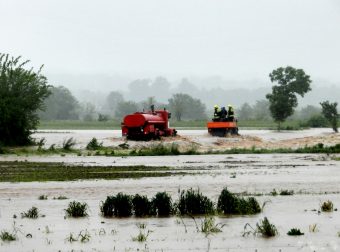Australia’s greenhouse gas emissions have flatlined due to the effects of the drought, which has caused a large drop in carbon dioxide from the agriculture sector.

The government’s quarterly greenhouse data for the year to June 2019, published on Friday, shows Australia’s emissions fell by 0.1% on the previous year – equivalent to 0.4m tonnes of carbon dioxide.
Previous government reports showed emissions had risen year-on-year since 2015. The latest report uses newly adjusted numbers for some sectors and instead suggests emissions have increased in some years, slightly dropped in others, but mostly been flat since the abolition of the carbon price scheme in 2014.
The small drop is the result of declining emissions from the agriculture and electricity sectors, which fell by 5.9% and 1.2% respectively. Emissions from transport decreased by 0.5%. But these decreases have been almost entirely offset by large increases from other parts of the economy.
Emissions from stationary energy, including manufacturing, construction and commercial sectors, rose by 3.6% and fugitive emissions are up by 4.4%. Both increases are largely due to the growth in the liquified natural gas (LNG) industry.
The sharp drop in emissions from agriculture shows the effect of widespread drought in NSW and Queensland and the impact of the Queensland floods in February. Both have led to significant drops in the amount of cattle on properties.
Tim Baxter, a senior climate solutions researcher at the Climate Council, said there were “two stories” beneath the data.
“Farmers are suffering. That’s part of the drop,” he said. “The other part of the drop is renewables deployment as a result of a whole bunch of projects coming online for the end of the renewable energy target.
“The drought is not something to celebrate, nor is the renewables sector at the moment which is facing a fairly big slump in investment.”
Baxter said the growth in the LNG sector was almost enough on its own to offset the fall in agricultural emissions and “the good work of the renewables sector”.
“This is a blip in our emissions that isn’t long for this world [due to] plans we have for gas in this country. It will go back up,” he said.
The emissions reduction minister, Angus Taylor, said the data emissions from electricity had fallen for the third consecutive year. He said emissions from producing Australia’s exports had increased as a share of total emissions from 30.1% to 37.5% over the past five years, largely due to the growth of the LNG industry.
Labor’s climate spokesman, Mark Butler, said the accounts showed that, on a seasonally adjusted and weather normalised basis, emissions continued to rise.
Adam Bandt, the Greens’ climate spokesman, said drought was “not an acceptable pollution reduction strategy”.
“The sad irony in these figures is that this small drop in pollution is itself due to climate inaction,” he said.
The decline in emissions from electricity was confirmed by the The Australia Institute’s monthly national energy emissions audit, which found pollution from the national grid continues to decline due to sharp decrease in coal-fired power.
Hugh Saddler, an energy expert who compiles the report for the institute, said Australia’s coal fleet was ageing, and increasingly requiring “sick leave” for repairs. “Power stations like Loy Yang A in Victoria are continually out of action,” he said.
Annual generation from coal peaked in January 2009. Since then, black coal generation has fallen 9%, brown coal electricity slumped by 41% and gas-fired power risen by 3%.
The decline in coal has been almost entirely replaced by an increase in wind power, rooftop solar panels, large-scale solar farms and hydro electricity.
Read more: Guardian



